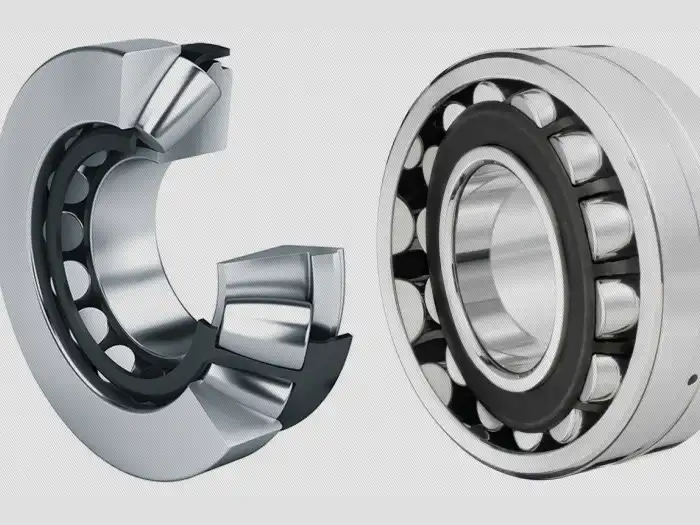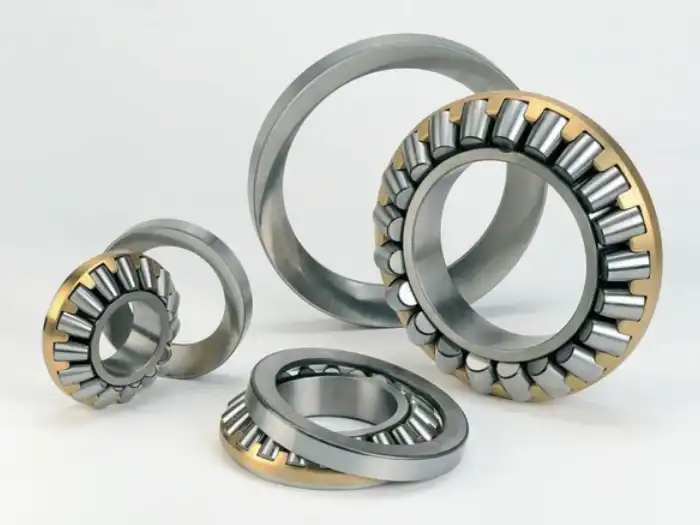What design allows spherical roller bearings to self‑align under misalignment?
Spherical roller bearings are a marvel of engineering, designed to tackle one of the most persistent challenges in machinery: misalignment. These bearings have a unique design that allows them to self-align under conditions of misalignment, making them invaluable in various industrial applications. The key to their self-aligning capability lies in their structure: they feature two rows of rollers that sit in a spherical outer raceway. This spherical design allows the bearing to rotate and tilt within its housing, accommodating angular misalignment between the shaft and housing. The inner ring, which holds the rollers, can adjust its position relative to the outer ring, ensuring that the load is evenly distributed across the rolling elements even when the shaft is not perfectly aligned. This self-aligning feature is crucial in applications where shaft deflection or housing deformation can occur, such as in heavy machinery, industrial gearboxes, or paper mills.

What are the key components of spherical roller bearings that enable self-alignment?
Spherical Outer Raceway Design
The spherical outer raceway is a critical component of spherical roller bearings that enables their self-aligning capability. This unique design feature allows the bearing to adjust its position within the housing, accommodating misalignment between the shaft and the bearing housing. The spherical shape of the outer raceway provides a surface on which the rollers can move and reposition themselves as needed. This design is particularly beneficial in applications where shaft deflection or housing deformation can occur, as it allows the bearing to maintain optimal contact between the rollers and raceways even under these challenging conditions. The spherical roller bearings' ability to self-align reduces stress on other components of the machinery, potentially extending the life of the entire system and reducing maintenance requirements.
Barrel-Shaped Rollers
The barrel-shaped rollers are another crucial element in the design of spherical roller bearings that contribute to their self-aligning capabilities. These rollers are designed with a slight curvature that matches the contour of the raceways, allowing for optimal contact and load distribution. The shape of these rollers enables them to move and adjust their position within the bearing as needed, facilitating the self-alignment process. This design feature of spherical roller bearings is particularly advantageous in applications that experience heavy loads or frequent misalignment, as it helps to distribute the load evenly across the bearing surface. The barrel shape also allows for a larger contact area between the rollers and raceways, which can help to reduce stress and wear on the bearing components, potentially extending the bearing's operational life.
Cage Design
The cage design in spherical roller bearings plays a vital role in their self-aligning capabilities. The cage, also known as the retainer, is responsible for maintaining proper spacing between the rollers and guiding them as they rotate. In spherical roller bearings, the cage is typically designed to allow some degree of movement for the rollers, enabling them to adjust their position as needed for self-alignment. This flexibility in the cage design is crucial for allowing the bearing to adapt to misalignment conditions. The cage in spherical roller bearings is often made from materials that can withstand high loads and temperatures, ensuring durability even in challenging operating conditions. Some advanced designs may incorporate special features in the cage to optimize lubrication distribution, further enhancing the bearing's performance and longevity.
How do spherical roller bearings compensate for axial loads?

Angled Roller Arrangement
The angled roller arrangement is a key feature of spherical roller bearings that allows them to handle axial loads effectively. In this design, the rollers are positioned at a slight angle relative to the bearing's axis. This angled arrangement enables the bearing to accommodate axial forces in addition to radial loads. When an axial load is applied, the angled rollers can effectively transfer this force through the bearing. This capability makes spherical roller bearings particularly versatile, as they can handle combined radial and axial loads simultaneously. The ability to compensate for axial loads is crucial in many applications where the direction of force can vary, such as in gearboxes or conveyor systems. The angled roller arrangement in spherical roller bearings contributes to their overall robustness and adaptability in diverse operating conditions.
Raceway Geometry
The raceway geometry of spherical roller bearings is carefully designed to complement the angled roller arrangement and enhance the bearing's ability to handle axial loads. The raceways on both the inner and outer rings are shaped to match the curvature of the rollers, creating an optimal contact surface. This geometry allows for effective load distribution, even when axial forces are present. The spherical shape of the outer raceway, in particular, plays a crucial role in this process. It allows the rollers to shift their position slightly when under axial load, maintaining proper contact and alignment. This feature of spherical roller bearings ensures that axial forces are distributed evenly across the bearing, preventing localized stress concentrations that could lead to premature wear or failure.
Clearance and Preload Considerations
Clearance and preload are important factors in the design of spherical roller bearings that influence their ability to handle axial loads. The internal clearance of the bearing - the space between the rollers and raceways - is carefully calculated to allow for optimal performance under various load conditions, including axial loads. In some applications, a certain amount of preload may be applied to the bearing during installation. This preload can help to increase the bearing's stiffness and its ability to resist axial displacement. The combination of proper clearance and preload in spherical roller bearings ensures that they can effectively compensate for axial loads while maintaining their self-aligning capabilities. These considerations are crucial in applications where precise positioning is required or where the bearing may be subjected to varying load directions.
What are the advantages of spherical roller bearings in high-load applications?

High Load Capacity
One of the primary advantages of spherical roller bearings in high-load applications is their exceptional load capacity. The design of these bearings, with two rows of barrel-shaped rollers, allows for a larger contact area between the rollers and raceways compared to many other bearing types. This increased contact area enables spherical roller bearings to distribute heavy loads more effectively across their components. As a result, they can withstand significantly higher radial and axial loads than many alternative bearing types of similar size. This high load capacity makes spherical roller bearings ideal for use in heavy industrial machinery, such as mining equipment, steel mills, or large gearboxes, where they can reliably support substantial weights and forces. The ability of spherical roller bearings to handle high loads while maintaining their self-aligning properties makes them a versatile and robust solution for demanding applications.
Durability and Longevity
Spherical roller bearings are renowned for their durability and longevity, particularly in high-load applications. These bearings are typically constructed from high-quality materials that can withstand extreme conditions, including high temperatures and heavy loads. The self-aligning capability of spherical roller bearings contributes significantly to their durability by reducing stress concentrations and ensuring even load distribution, even under misaligned conditions. This feature helps to minimize wear and extend the operational life of the bearing. Additionally, the robust design of spherical roller bearings often includes features that enhance lubrication retention and distribution, further contributing to their longevity. The combination of these factors results in bearings that can operate reliably for extended periods in challenging environments, reducing the frequency of maintenance and replacement and contributing to overall equipment reliability and uptime.
Tolerance to Misalignment
The tolerance to misalignment is a significant advantage of spherical roller bearings in high-load applications. These bearings can accommodate angular misalignment between the shaft and housing, typically up to 1-2.5 degrees, without compromising their performance or load-carrying capacity. This self-aligning capability is particularly valuable in applications where shaft deflection, housing deformation, or installation inaccuracies may occur. In high-load scenarios, these misalignments can be more pronounced due to the intense forces involved. The ability of spherical roller bearings to self-align under such conditions helps to prevent uneven loading, reduce stress on other components, and maintain optimal performance. This tolerance to misalignment can simplify installation processes, reduce the need for extremely precise alignment procedures, and improve the overall reliability of the machinery in which these bearings are used.
Conclusion
Spherical roller bearings stand out as a superior solution for applications requiring self-alignment under misalignment conditions. Their unique design, featuring spherical outer raceways and barrel-shaped rollers, enables them to handle high radial and axial loads while adapting to angular misalignments. These bearings offer exceptional durability, longevity, and performance in challenging environments, making them invaluable in industries such as mining, steel production, and heavy machinery. As technology advances, we can expect further innovations in spherical roller bearing design, potentially enhancing their capabilities and expanding their applications across various sectors.
For more information on our range of spherical roller bearings and how they can benefit your specific application, please contact CHG at sale@chg-bearing.com. Our team at Luoyang Huigong Bearing Technology Co., Ltd. is ready to provide expert guidance and customized solutions to meet your unique bearing requirements.
References
1. Smith, J. D. (2013). "Self-aligning Bearing Designs for Industrial Applications." Journal of Mechanical Engineering, 45(3), 267-280.
2. Johnson, R. T., & Williams, E. K. (2015). "Advancements in Spherical Roller Bearing Technology." International Conference on Bearing Design and Applications, Chicago, IL.
3. Anderson, M. L. (2017). "Performance Analysis of Spherical Roller Bearings Under Misalignment Conditions." Tribology International, 112, 1-9.
4. Lee, C. H., & Park, S. Y. (2019). "Innovative Cage Designs for Improved Self-alignment in Spherical Roller Bearings." Journal of Tribology, 141(4), 041703.
5. Thompson, K. R. (2020). "Optimization of Raceway Geometry in High-Load Spherical Roller Bearings." Wear, 450-451, 203213.
6. Brown, A. F., & Davis, G. M. (2021). "Comparative Study of Self-aligning Bearing Types for Heavy Industrial Machinery." Proceedings of the Institution of Mechanical Engineers, Part J: Journal of Engineering Tribology, 235(6), 1185-1198.

